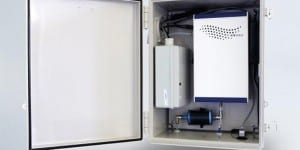Airsense Analytics GmbH and PCA Technologies Srl have developed OlfoSense, a tool that can be used to create a network for odour leakages monitoring over large areas and at the perimeter of plants.
Described as “the most technologically advanced tool for the determination of odour levels and other important chemical volatile compounds”, the system works with concentration and meteorological data, displaying in real time the effects of the odour/compounds spreading in the area under study. The network is connected to a central server.
Olfosense monitors odour level (OU/m3), total VOCs (Volatile Organic Compounds), H2S and NH3 concentrations.

For monitoring a large area like a big landfill, OlfoSense units can be placed around the perimeter, with all data collected being sent via UMTS / WIFI / LAN connection to a control room, where users can set alarm thresholds and configure the system to keep them appropriately informed.
A similar approach can be used whether the plant in question is for composting, AD, chemical and petrochemical production or other sites which might present a requirement for continuous measurement of odour leakage 24 hours a day. These plants usually bring high impacts and environmental risks; residents complain about odours and this perception increases concern and fear for their health, says Airsense Analytics. The OlfoSense Network guarantees protection in these dangerous cases, where the Government office overseeing environmental protection can immediately react if thresholds are exceeded. OlfoSense is a versatile device and can be successfully applied in the case of urban air monitoring.
A weather station can be interconnected with the Olfosense network, integrating data such as wind speed and direction, temperature, radiation, pressure and humidity.
Afterwards the software displays in real time how smell falls in the area, showing the diffusion plume impact on sensitive receptors nearby.
The diffusion plume is displayed with isolines that show the dilution of spreading compounds.







